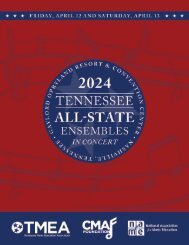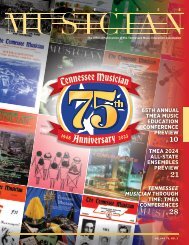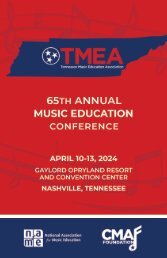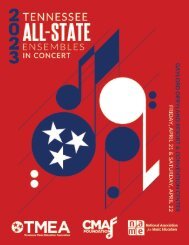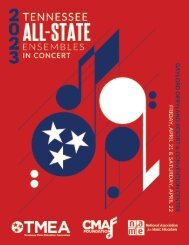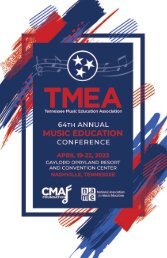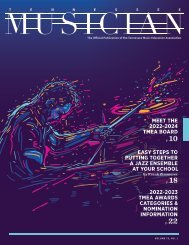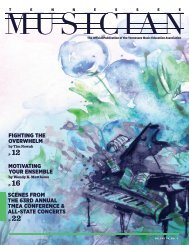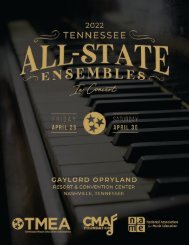TN Musician Vol. 70 No. 4
You also want an ePaper? Increase the reach of your titles
YUMPU automatically turns print PDFs into web optimized ePapers that Google loves.
WORKING TOWARD<br />
PROVIDING A POSITIVE<br />
LEARNING ENVIRONMENT<br />
FOR ALL STUDENTS, WE ARE<br />
FACED WITH THE CHALLENGE<br />
OF MEETING THE NEEDS OF A<br />
VERY DIVERSE POPULATION<br />
OF LEARNING STYLES AND<br />
BEHAVIORS.<br />
based on preparation, organization and planning prior to the start of<br />
each class, as well as, evaluation and adjustments during each class.<br />
We must accept all students into our music classes. First and foremost,<br />
communication prior to the placement of the special needs or<br />
at-risk student will help alleviate many challenges that tend to occur<br />
throughout the year. All placement decisions should be based on the<br />
child’s ability to function in the music class and the teacher’s ability<br />
to accommodate the child’s needs. It is imperative that the team of<br />
educators associated with the special needs or at-risk student meet<br />
prior to the student’s inclusion into the music class. At this meeting,<br />
in order to design a curriculum plan best suited for the individual<br />
student, the diagnoses and functioning levels of the student need to<br />
be addressed, evaluated and discussed. The following topics should<br />
be included in the discussion: eligibility category of the student, academic<br />
strengths, academic concerns, level of reading comprehension,<br />
level of writing ability, required accommodations, social strengths,<br />
social concerns, “triggers” that might upset the student, techniques<br />
to de-escalate student’s negative behavior, techniques for rewarding<br />
student’s positive behavior, social accommodations, physical conditions,<br />
physical accommodations, mental conditions, goals for inclusion<br />
into the class and the type of grading best suited for this student.<br />
Once the child is enrolled in the class, and the teacher has knowledge<br />
of the child’s abilities and challenges, lessons need to be well<br />
planned prior to the start of each class. In order for music lessons to<br />
be effective, the lesson plan must be focused on the desired outcome.<br />
What is the intent or purpose of the lesson? What are the benefits for<br />
the students? The following list of benefits is not all inclusive but<br />
provides a starting point for the preparation of a lesson plan: tools<br />
for developing social skills, organizing and/or managing behavior,<br />
developing cognition skills, developing communication skills, developing<br />
motor functioning skills, developing listening skills. With a<br />
diverse population of students in our classes, we may have to design<br />
multiple lessons plans for one class as we strive to meet the needs of<br />
our students with special needs, at-risk behaviors, non-official needs<br />
or just being a regular child.<br />
One of my “typical” classes may consist of 25 students with scholastic<br />
abilities ranging from advance placement students to students in<br />
the Contained Learning Center (CLC). Throughout each activity I<br />
must observe, assess and adjust the participation of each student.<br />
In a single activity, during the course of a lesson, I must modify the<br />
lesson so that every student has the opportunity to participate at his<br />
or her own ability level. The modification may be adjusting the music<br />
so it is challenging for one student and simplified for another. This<br />
task must be accomplished in a seamless manner so that the entire<br />
class can continue to play the music. Just as a fine chef delivers the<br />
meal at the same time to a party of 25, we must serve our students at<br />
the same time in an individualistic, yet holistic and organic manner.<br />
We must be organized and prepared to teach each class effectively.<br />
To the same degree of importance, we must be ready to be flexible<br />
enough to change our lesson based on the needs of our students. We<br />
must remember that the music and the students dictate to us how we<br />
must adjust our lesson plans. It is our job to give ourselves permission<br />
to “shift gears” during a lesson.<br />
Working toward providing a positive learning environment for all<br />
students, we are faced with the challenge of meeting the needs of a<br />
very diverse population of learning styles and behaviors. In order to<br />
diminish the occurrence of negative behavior in the classroom it is<br />
imperative for the music educator to offer experiences that encourage<br />
the child to be engaged, and on task, during daily classroom activities<br />
(Taylor et al., 1997). Our lesson plans must be designed to assist in<br />
motivating students toward desiring to become healthy, valuable,<br />
contributing members of our music class.<br />
Let’s be honest, in order for students to be engaged in classroom activities,<br />
the curriculum must be interesting and the teacher must<br />
be motivating. Even a passionate teacher would have difficulties<br />
engaging students in a boring, non-relevant curriculum. As music<br />
educators, we must offer experiences that will encourage our students<br />
to become engaged with their school environment, change their attitude,<br />
select healthy choices and discontinue behaviors that disrupt<br />
their education and the education of their peers. Our music classes<br />
should be designed to provide opportunities for the student to become<br />
engaged in school activities and encouraged to be motivated toward<br />
being successful in life. Designing and implementing an engaging<br />
curriculum is the first step toward success.<br />
The curriculum design for my general music class is based on handson<br />
activities that address the development of focus, respect and community<br />
awareness: principles necessary in addressing and modifying<br />
at-risk behaviors. The lessons are based on a combination of Will<br />
Schmid’s “World Music Drumming Curriculum” (WMDC) and arrangements<br />
of traditional Ghanaian music. The WMDC provides an<br />
opportunity for students to develop listening and focusing skills, and<br />
develop a solid foundation of basic playing techniques necessary in<br />
the study of World Music. The World Music, with an emphasis on<br />
Ghanaian music, incorporated in this curriculum focuses on the<br />
importance of the individual within the community while playing<br />
rhythmic patterns, and combinations of rhythmic patterns, that require<br />
the student to concentrate on the music and listen attentively<br />
24 | TENNESSEE MUSICIAN | 2018 | <strong>Vol</strong>ume <strong>70</strong>, <strong>No</strong>. 4



